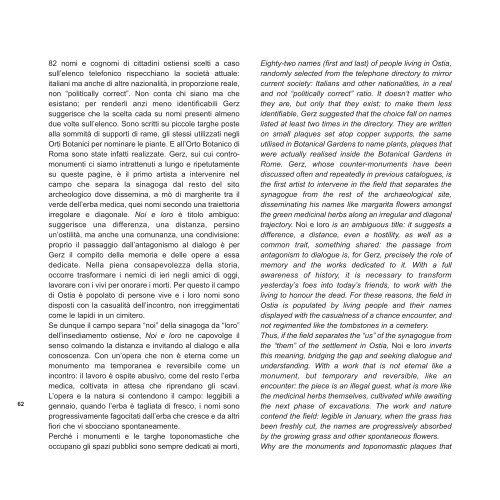Adachiara Zevi - arteinmemoria
Adachiara Zevi - arteinmemoria
Adachiara Zevi - arteinmemoria
Create successful ePaper yourself
Turn your PDF publications into a flip-book with our unique Google optimized e-Paper software.
62<br />
82 nomi e cognomi di cittadini ostiensi scelti a caso<br />
sull’elenco telefonico rispecchiano la società attuale:<br />
italiani ma anche di altre nazionalità, in proporzione reale,<br />
non “politically correct”. Non conta chi siano ma che<br />
esistano; per renderli anzi meno identificabili Gerz<br />
suggerisce che la scelta cada su nomi presenti almeno<br />
due volte sull’elenco. Sono scritti su piccole targhe poste<br />
alla sommità di supporti di rame, gli stessi utilizzati negli<br />
Orti Botanici per nominare le piante. E all’Orto Botanico di<br />
Roma sono state infatti realizzate. Gerz, sui cui contromonumenti<br />
ci siamo intrattenuti a lungo e ripetutamente<br />
su queste pagine, è il primo artista a intervenire nel<br />
campo che separa la sinagoga dal resto del sito<br />
archeologico dove dissemina, a mò di margherite tra il<br />
verde dell’erba medica, quei nomi secondo una traiettoria<br />
irregolare e diagonale. Noi e loro è titolo ambiguo:<br />
suggerisce una differenza, una distanza, persino<br />
un’ostilità, ma anche una comunanza, una condivisione:<br />
proprio il passaggio dall’antagonismo al dialogo è per<br />
Gerz il compito della memoria e delle opere a essa<br />
dedicate. Nella piena consapevolezza della storia,<br />
occorre trasformare i nemici di ieri negli amici di oggi,<br />
lavorare con i vivi per onorare i morti. Per questo il campo<br />
di Ostia è popolato di persone vive e i loro nomi sono<br />
disposti con la casualità dell’incontro, non irreggimentati<br />
come le lapidi in un cimitero.<br />
Se dunque il campo separa “noi” della sinagoga da “loro”<br />
dell’insediamento ostiense, Noi e loro ne capovolge il<br />
senso colmando la distanza e invitando al dialogo e alla<br />
conoscenza. Con un’opera che non è eterna come un<br />
monumento ma temporanea e reversibile come un<br />
incontro: il lavoro è ospite abusivo, come del resto l’erba<br />
medica, coltivata in attesa che riprendano gli scavi.<br />
L’opera e la natura si contendono il campo: leggibili a<br />
gennaio, quando l’erba è tagliata di fresco, i nomi sono<br />
progressivamente fagocitati dall’erba che cresce e da altri<br />
fiori che vi sbocciano spontaneamente.<br />
Perché i monumenti e le targhe toponomastiche che<br />
occupano gli spazi pubblici sono sempre dedicati ai morti,<br />
Eighty-two names (first and last) of people living in Ostia,<br />
randomly selected from the telephone directory to mirror<br />
current society: Italians and other nationalities, in a real<br />
and not “politically correct” ratio. It doesn’t matter who<br />
they are, but only that they exist; to make them less<br />
identifiable, Gerz suggested that the choice fall on names<br />
listed at least two times in the directory. They are written<br />
on small plaques set atop copper supports, the same<br />
utilised in Botanical Gardens to name plants, plaques that<br />
were actually realised inside the Botanical Gardens in<br />
Rome. Gerz, whose counter-monuments have been<br />
discussed often and repeatedly in previous catalogues, is<br />
the first artist to intervene in the field that separates the<br />
synagogue from the rest of the archaeological site,<br />
disseminating his names like margarita flowers amongst<br />
the green medicinal herbs along an irregular and diagonal<br />
trajectory. Noi e loro is an ambiguous title: it suggests a<br />
difference, a distance, even a hostility, as well as a<br />
common trait, something shared: the passage from<br />
antagonism to dialogue is, for Gerz, precisely the role of<br />
memory and the works dedicated to it. With a full<br />
awareness of history, it is necessary to transform<br />
yesterday’s foes into today’s friends, to work with the<br />
living to honour the dead. For these reasons, the field in<br />
Ostia is populated by living people and their names<br />
displayed with the casualness of a chance encounter, and<br />
not regimented like the tombstones in a cemetery.<br />
Thus, if the field separates the “us” of the synagogue from<br />
the “them” of the settlement in Ostia, Noi e loro inverts<br />
this meaning, bridging the gap and seeking dialogue and<br />
understanding. With a work that is not eternal like a<br />
monument, but temporary and reversible, like an<br />
encounter: the piece is an illegal guest, what is more like<br />
the medicinal herbs themselves, cultivated while awaiting<br />
the next phase of excavations. The work and nature<br />
contend the field: legible in January, when the grass has<br />
been freshly cut, the names are progressively absorbed<br />
by the growing grass and other spontaneous flowers.<br />
Why are the monuments and toponomastic plaques that


